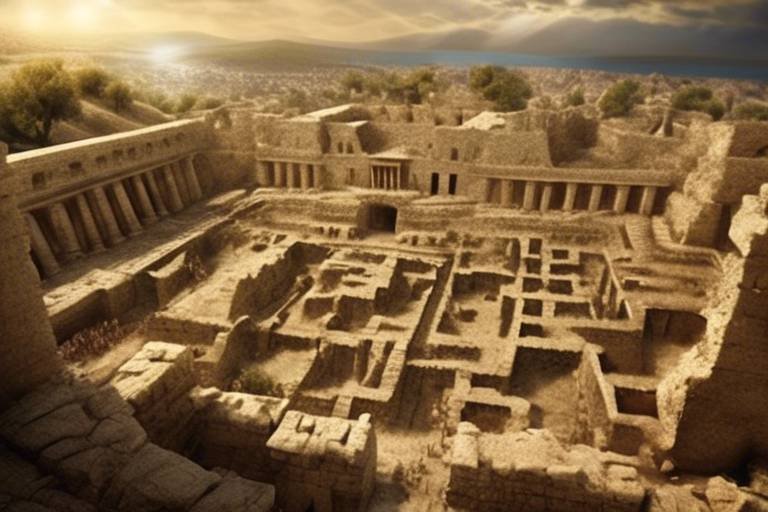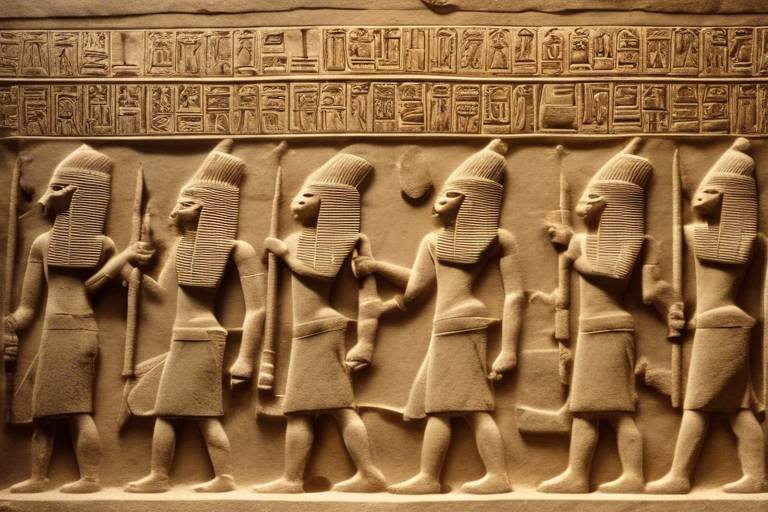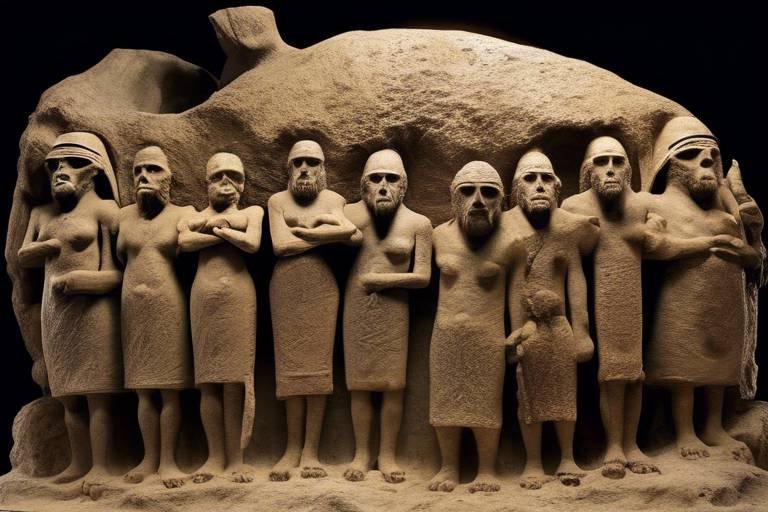The Forgotten Societies of the Arctic Circle
When we think of the Arctic Circle, we often picture a vast expanse of icy landscapes and polar bears roaming the frozen tundra. However, beyond the icy wilderness, there exist forgotten societies with rich cultures and traditions that have endured for centuries in this harsh environment. These indigenous communities have developed unique ways of life that are intricately tied to the Arctic's unforgiving terrain, facing challenges and struggles that are often overlooked by the modern world.
One of the most well-known indigenous groups in the Arctic Circle is the Inuit communities. These resilient people have thrived in the Arctic regions of North America for generations, adapting to the extreme cold and harsh conditions with their sustainable practices. The Inuit culture is deeply rooted in a deep respect for nature and a strong sense of community, making them an integral part of the Arctic's ecosystem.
Another group that calls the Arctic Circle home is the Sami people, known for their traditional nomadic lifestyle and reindeer herding practices. The Sami have a rich cultural heritage that revolves around their close bond with nature and their reindeer herds. Despite their struggles for recognition and preservation of their language and customs, the Sami continue to uphold their traditions in the face of modernization.
Exploring the lesser-known Chukchi and Evenki tribes reveals a world of unique traditions and spiritual beliefs that are deeply intertwined with the Arctic landscape. These indigenous groups have preserved their cultural identity through generations, but the encroachment of modern ways of life poses a threat to their traditional practices and way of life.
The Yukaghir society offers a glimpse into the history of the Arctic Circle, with their hunting and gathering practices and rich oral traditions. As they navigate the challenges of the contemporary world, the Yukaghir people strive to maintain their cultural heritage and pass down their knowledge to future generations.
Among the indigenous groups in the Arctic Circle are the Nenets reindeer herders, who have forged a deep connection with nature through their traditional lifestyle and migration patterns. However, the impacts of climate change pose a significant threat to their way of life, highlighting the importance of sustainable practices and environmental conservation.
The Even people of Siberia stand out for their unique culture, shamanistic beliefs, and traditional craftsmanship. Despite facing modern challenges, the Even people continue to preserve their storytelling traditions and adapt to the changing world while holding on to their cultural roots.
Delving into the Nganasan community sheds light on their hunting traditions, spiritual ceremonies, and efforts to preserve their cultural practices in a rapidly evolving world. The Nganasan people's resilience and determination to safeguard their heritage reflect the ongoing struggle of indigenous communities in the Arctic Circle.
As we reflect on the lives of these forgotten societies, it becomes evident that alienation and preservation are pressing issues that need to be addressed. The erosion of cultural identities and the threat of losing ancestral traditions underscore the importance of sustainable development and cross-cultural understanding to protect the unique way of life of these indigenous groups in the Arctic Circle.

Inuit Communities
When it comes to the Arctic Circle, the stand out as one of the most resilient and culturally rich groups. The Inuit people have a deep history rooted in the icy landscapes of the Arctic, where they have thrived for generations. Their way of life is intricately connected to the harsh environment they call home, shaping their traditions and practices.
Living in close harmony with nature, the Inuit have developed sustainable practices that allow them to thrive in challenging conditions. Their traditional lifestyle revolves around hunting, fishing, and gathering, with a strong emphasis on community cooperation and sharing resources. The Inuit's deep respect for the land and sea is evident in their spiritual beliefs and cultural ceremonies, which honor the natural world that sustains them.
One of the most fascinating aspects of Inuit culture is their intricate knowledge of the Arctic environment. From navigating icy waters to building snow shelters, the Inuit have honed their survival skills over centuries, passing down their wisdom through oral traditions and storytelling. This deep connection to the land is a central aspect of their identity, shaping their worldview and values.
Despite their resilience and adaptability, the Inuit communities face numerous challenges in the modern world. Climate change, industrial development, and globalization are threatening their way of life, putting pressure on their traditional practices and cultural heritage. As the Arctic landscape undergoes rapid transformation, the Inuit people must navigate a delicate balance between preserving their traditions and embracing the changes that come with modernity.
Preserving the unique culture and heritage of the Inuit communities is crucial not only for their own identity but also for the world at large. Their traditional knowledge of the Arctic ecosystem, sustainable practices, and resilient spirit hold valuable lessons for humanity as we grapple with environmental challenges and seek to build a more sustainable future.

Sami People
The Sami people, also known as the Saami or Sámi, are indigenous inhabitants of the Arctic Circle, primarily living in Sápmi, which encompasses parts of Norway, Sweden, Finland, and Russia. Their traditional nomadic lifestyle revolves around reindeer herding, a practice deeply intertwined with their cultural identity. The Sami people have a rich cultural heritage, characterized by their unique language, traditional clothing, and distinctive handicrafts.
For centuries, the Sami have relied on reindeer herding as a means of sustenance, transportation, and trade. This ancient practice not only sustains their livelihood but also serves as a symbol of their connection to the land and nature. However, modernization and industrialization have posed significant challenges to the traditional Sami way of life, threatening their reindeer herding practices and cultural survival.
The Sami people have long fought for recognition and preservation of their language, customs, and land rights. They have faced historical marginalization and discrimination, leading to struggles for cultural autonomy and self-determination. Efforts to revitalize and maintain their cultural heritage have become increasingly important in the face of rapid societal changes and globalization.
Despite the challenges they face, the Sami people continue to uphold their traditions and pass down their knowledge through generations. Their resilience and determination to preserve their way of life reflect a deep-rooted connection to their ancestral lands and a profound respect for nature. By safeguarding their cultural practices and promoting cross-cultural understanding, the Sami strive to ensure the survival of their unique identity for future generations.

Chukchi and Evenki Tribes
Nestled in the icy expanse of the Arctic Circle lie the forgotten societies, each with a rich tapestry of culture, tradition, and resilience. Let's delve into the lives of these unique communities, shedding light on their challenges and the importance of preserving their heritage for generations to come.
Among the snow-capped landscapes of the Arctic Circle, the Inuit communities stand as pillars of strength, embodying a deep connection to the land and sea. Their history is woven with tales of survival, their lifestyle harmonizing with nature in a dance of sustainability and respect.
Roaming the vast tundra, the Sami people carry with them a legacy of reindeer herding and nomadic traditions. Their cultural heritage is a treasure trove of stories and songs, yet they face the uphill battle of preserving their language and customs in a rapidly changing world.
Amidst the Arctic winds, the Chukchi and Evenki tribes carve out their existence with unique traditions and spiritual beliefs. As modernization encroaches upon their lands, these lesser-known communities grapple with the challenge of maintaining their way of life.
Deep in the heart of the Arctic Circle, the Yukaghir society thrives on hunting and gathering, passing down oral traditions through generations. Yet, the modern world poses obstacles to their survival, testing their resilience in the face of change.
For the Nenets people, the rhythm of life is intertwined with the migration of reindeer across the Arctic plains. Their bond with nature is unbreakable, but the specter of climate change looms large, threatening their age-old practices and livelihood.
Within the frozen embrace of Siberia's Arctic Circle, the Even people uphold a culture steeped in shamanistic beliefs and craftsmanship. As they navigate the complexities of the modern world, their resilience shines through, a beacon of tradition in a sea of change.
In the Arctic silence, the Nganasan community carries forward their hunting traditions and spiritual ceremonies. As the world around them evolves, they strive to keep their language alive and preserve the essence of their cultural identity.
As the winds of change sweep across the Arctic Circle, the forgotten societies face the threat of alienation and cultural erosion. It is imperative to champion sustainable development and cross-cultural understanding to safeguard their unique identities and way of life.
Within the Arctic Circle, the Chukchi and Evenki tribes stand as guardians of ancient traditions and spiritual beliefs. Their way of life, deeply rooted in the land and the spirits that dwell within it, faces the encroachment of modernization. As they navigate this delicate balance, preserving their cultural heritage becomes a paramount challenge, a testament to their resilience in the face of change.

Yukaghir Society
Nestled in the icy expanse of the Arctic Circle lie the , a group whose history and cultural heritage are as rich and diverse as the snow-covered landscapes they call home. The Yukaghirs have long thrived in this harsh environment, relying on their deep connection to nature and time-honored traditions to sustain their way of life.
Originating from the Siberian region of the Arctic Circle, the Yukaghir people are renowned for their hunting and gathering practices, which have been passed down through generations. These practices are not merely a means of survival but also a reflection of their deep spiritual beliefs and respect for the land that provides for them.
One of the most fascinating aspects of Yukaghir culture is their oral traditions, which serve as a repository of knowledge, history, and folklore. Through storytelling and songs, the Yukaghirs preserve their past and pass down valuable lessons to the younger members of their community.
Despite their resilience and adaptability, the Yukaghir Society faces numerous challenges in the contemporary world. The encroachment of modernization, environmental changes, and the erosion of traditional practices pose significant threats to their way of life, forcing them to navigate a delicate balance between preserving their heritage and embracing the future.
Efforts to protect and promote Yukaghir culture are crucial in ensuring the survival of this unique society. By raising awareness about their traditions, advocating for their rights, and fostering cross-cultural understanding, we can contribute to the preservation of the Yukaghir way of life for generations to come.

Nenets Reindeer Herders
The Nenets reindeer herders are a fascinating group of people who have thrived in the harsh conditions of the Arctic Circle for centuries. Their traditional lifestyle revolves around herding reindeer, which not only provides them with food and clothing but also forms the core of their cultural identity. The Nenets people have a deep connection with nature, viewing the reindeer as more than just livestock but as companions in their nomadic journey across the tundra.
One of the most remarkable aspects of the Nenets way of life is their migration patterns. Twice a year, they undertake long and arduous journeys with their reindeer herds, covering hundreds of miles to reach seasonal pastures. This nomadic lifestyle requires intricate knowledge of the land and a harmonious relationship with their animal counterparts. The Nenets people have mastered the art of survival in the extreme conditions of the Arctic, relying on their herds for sustenance and warmth.
Climate change poses a significant threat to the Nenets reindeer herders, as rising temperatures and unpredictable weather patterns disrupt their traditional way of life. The melting permafrost and shrinking ice cover make it increasingly challenging for the reindeer to find food, leading to a decline in herd sizes and threatening the sustainability of the Nenets community. Despite these challenges, the Nenets people continue to adapt and innovate, seeking new ways to preserve their cultural heritage in the face of environmental changes.
The Nenets reindeer herders also face social and economic pressures, as modernization encroaches on their traditional territories. The influx of technology, infrastructure development, and changing societal norms pose a threat to the unique identity of the Nenets people. As they navigate the complexities of a rapidly changing world, the Nenets reindeer herders strive to maintain their cultural practices and pass down their knowledge to future generations.
Preserving the way of life of the Nenets reindeer herders is crucial not only for the survival of their community but also for the preservation of the Arctic ecosystem as a whole. Their sustainable practices and deep respect for nature offer valuable lessons in coexisting with the environment, reminding us of the importance of maintaining a balance between human activities and the natural world. By supporting initiatives that protect the rights and traditions of the Nenets people, we can ensure that their unique culture continues to thrive for generations to come.

Even People of Siberia
The Even people of Siberia, also known as the Evenks, are an indigenous group with a rich cultural heritage deeply rooted in the Arctic Circle. Living in the vast expanses of Siberia, these nomadic herders have maintained their traditional way of life for centuries, relying on reindeer herding as a primary source of sustenance and livelihood. The Evenks have a profound connection to the land, viewing nature as a sacred entity that sustains their existence.
One of the most fascinating aspects of the Even people's culture is their shamanistic beliefs. Shamans play a vital role in Even society, acting as intermediaries between the human and spiritual realms. Through rituals, ceremonies, and trance-like states, shamans communicate with the spirits to heal the sick, predict the future, and maintain harmony within the community.
The craftsmanship of the Even people is renowned for its intricacy and beauty. From intricately embroidered clothing to skillfully crafted tools and weapons, their artisanal skills are a testament to their cultural heritage and ingenuity. Each piece tells a story, reflecting the history and traditions of the Evenks.
Storytelling is another integral part of Even culture, with oral traditions passed down through generations. Through myths, legends, and epic tales, the Even people preserve their history and values, ensuring that their heritage endures despite the challenges of modernity.
Adaptation is key for the Evenks as they navigate the complexities of the modern world while holding onto their traditions. Climate change, industrialization, and cultural assimilation pose significant threats to their way of life, prompting the Even people to find innovative solutions to preserve their identity and customs.
In conclusion, the Even people of Siberia embody resilience, creativity, and a deep connection to their ancestral lands. By embracing their cultural heritage, adapting to change, and advocating for their rights, the Evenks stand as a testament to the enduring spirit of the forgotten societies in the Arctic Circle.

Nganasan Community
The Nganasan community, nestled in the Arctic Circle, holds a rich history and unique cultural practices that are integral to their way of life. This indigenous group, known for their hunting traditions and spiritual ceremonies, has long thrived in harmony with the harsh Arctic environment. The Nganasan people have developed a deep connection to the land, relying on their expertise in hunting to sustain their community.
One of the most fascinating aspects of the Nganasan culture is their spiritual ceremonies, which play a significant role in their belief system. These ceremonies are deeply rooted in nature and are conducted to honor the spirits and seek guidance for the community. Through these rituals, the Nganasan people maintain a strong connection to their ancestors and the spiritual world.
Despite the challenges posed by modernization and climate change, the Nganasan community remains dedicated to preserving their cultural heritage. Efforts are being made to document and pass down their language, traditions, and hunting practices to younger generations. The Nganasan people understand the importance of maintaining their identity in the face of external pressures.
As the world around them continues to evolve, the Nganasan community faces the ongoing task of balancing tradition with adaptation. Their resilience and commitment to preserving their way of life serve as a testament to the strength of indigenous cultures in the Arctic Circle. By sharing their stories and traditions, the Nganasan people contribute to the diverse tapestry of cultures that make up the Arctic region.

Alienation and Preservation
Alienation and Preservation in the Arctic Circle are pressing issues that demand attention and action. The rapid pace of modernization and globalization has brought both opportunities and challenges to the indigenous societies living in these remote regions. As the world around them changes at a dizzying speed, the cultural identities and traditional ways of life of these forgotten communities are under threat.
One of the primary concerns facing these societies is the sense of alienation experienced by the younger generations. As they navigate between the modern world and their ancestral traditions, they often find themselves caught in a cultural limbo. The pull of technology and urbanization can lead to a loss of connection with their roots, leaving them feeling adrift in a rapidly changing world.
Preserving the unique cultures and heritage of these Arctic communities is crucial not only for their own well-being but also for the global diversity of human experience. The traditional knowledge and sustainable practices honed over generations hold invaluable lessons for environmental conservation and harmony with nature.
Efforts to preserve and revitalize the cultural identities of these societies are underway, with initiatives focusing on language revitalization, cultural education, and community empowerment. By empowering the members of these communities to take pride in their heritage and pass on their traditions to future generations, we can ensure the sustainability and resilience of these unique Arctic cultures.
Frequently Asked Questions
- What are the main challenges faced by the forgotten societies in the Arctic Circle?
The main challenges faced by the forgotten societies in the Arctic Circle include cultural erosion, alienation from modern society, climate change impacting their traditional way of life, and the struggle to preserve their unique languages and customs.
- How can we contribute to preserving the cultural heritage of these Arctic communities?
You can contribute to preserving the cultural heritage of Arctic communities by supporting sustainable development initiatives, raising awareness about their traditions and challenges, respecting their way of life, and engaging in cross-cultural exchanges to foster understanding and appreciation.
- What are some traditional practices that these indigenous societies engage in?
These indigenous societies engage in traditional practices such as reindeer herding, hunting and gathering, storytelling, spiritual ceremonies, craftsmanship, and maintaining a deep connection with nature through their nomadic lifestyles.
- Why is it important to safeguard the identities of these forgotten societies?
It is important to safeguard the identities of these forgotten societies in the Arctic Circle to preserve cultural diversity, promote cultural heritage for future generations, and ensure the continuation of unique traditions that hold valuable insights into sustainable living and harmonious coexistence with nature.



















